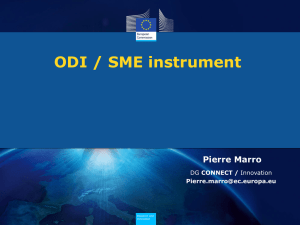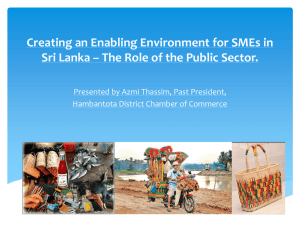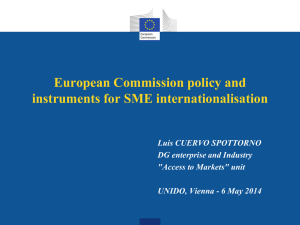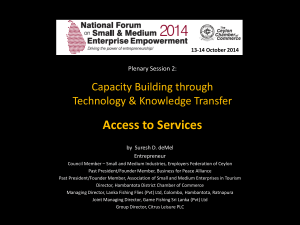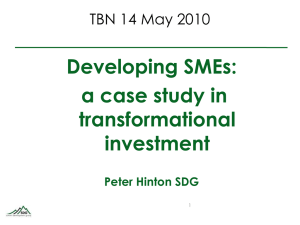International Experience in Developing and Supporting SMEs
advertisement
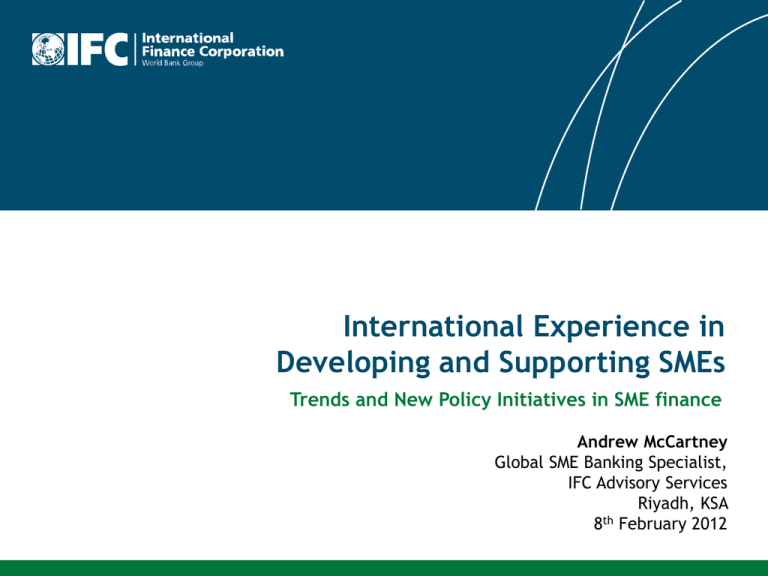
International Experience in Developing and Supporting SMEs Trends and New Policy Initiatives in SME finance Andrew McCartney Global SME Banking Specialist, IFC Advisory Services Riyadh, KSA th 8 February 2012 Key Messages •SME’s can play a major role in economic development, particularly in emerging markets •Access to finance remains a key constraint however, particularly in MENA •IFC as part of G20 SME Finance sub-group recently completed a review of global SME finance practices and reviewed 164 different models submitted A number of key trends and recommendations emerged out of the findings from the G20 work: Legal & Regulatory framework reform needs to drive changes in structure of financial services to support SME growth Financial infrastructure needs to be strengthened for greater SME transparency Public sector interventions need to remain focused and avoid market distortions Emergence of specific sub-segments of focus in SME Capacity needs to be developed in financial institutions •IFC as a knowledge leader in SME finance has a range of knowledge collateral available to support SME development 2 Presentation Title Access to finance remains a key constraint, particularly for SMEs across the GCC Access to finance represents one of the major drivers for SME growth GCC shows particularly low levels of SME lending penetration SME loans/ total loans (%) Source: Bank lending to SMEs in MENA Survey Report, World bank and Union of Arab banks, 2010 Source: Doing business report 2010, World Bank, Enterprise survey 3 IFC has recently completed a review of leading SME finance practices and models as part of our work with the G20 G20 SME finance Sub Group identified successful models & policy measures for SMEs in 2011 Work involved review of 164 different interventions globally and subsequent policy requirements Resulted in nine major recommendations to support SME growth Key Recommendations from the G20 Sub-Group Developing specific country strategies Developing supporting legal & Regulatory framework Strengthening the financial infrastructure Effective government support mechanisms Building reliable data sources for SME finance Building the capacity of financial institutions Address specific market failures e.g. women and agriculture Establish a Global SME finance Forum as a knowledge sharing platform 4 SME Finance Policy Guide – issued October 2011 by IFC Legal and regulatory environment reform needs to drive competition and access to finance for SMEs in MENA Licensing requirements need to be relaxed without sacrificing quality but enable significantly increased competition levels Case Study: NAFIN, Mexico Provides on-line factoring services to SME suppliers Support non-FI alternatives to bank lending in the market e.g. leasing and factoring “Productive chains” program allows SMEs to use big buyer receivables for working capital finance Strengthen credit reporting to even the playing field between small and big banks Credit risk of the SME effectively gets transferred to higher quality corporate customers Ensure effective monitoring of data for effectiveness of measures By 2009, nearly 500 Corporates involved, and $60 Billion in finance extended to more than 80,000 SMEs through 21 banks and non-banks 5 Financial infrastructure needs to be strengthened for improved transparency of SMEs Accounting and audit requirements need a balance between transparency & regulatory simplicity Case Study: SME Rating Agency of India Credit bureau & registries need complimentary systems for personal and business information from all players (ie FI and Non-FI) India’s 1st rating agency for MSME’s Diversified equity ownership by 11 banks allowed lenders to accept rating and extend financial and non-financial benefits SME rating agencies offer a potential alternative, but need a certain critical market size (e.g. India) SMEs are bucketed by size for peer comparisons Rating fee of over $1100, subsidized by the government by 75% SMERA forecast to reach out to over 80,000 SMEs over the next 5 years Source: SMERA Website, 2001 6 Financial infrastructure needs to be strengthened for venture capital and private equity access to the SME market Secured transaction regimes should allow for a wide range of enforceable collateral & out of court enforcement options Improve corporate governance practices should allow venture Capital/ private Equity access to SMEs SME stock Exchanges have only proven marginally useful due to low volumes and a lack of investor interest Case Study: INOVAR Program, Brazil Objective: to strengthen investment in new technology SMEs and to establish Venture capital Created a research and information dissemination platform and developed mgt capacity to accelerate VC investment Established a VC portal where investors and entrepreneurs register Allows for the provision of business plans and joint due diligence for VC funds 20 venture forums established and over $1 billion in VC/ PE investment made in SMEs 7 Effective public sector intervention needs to build SME capacity and avoid market distortion Credit guarantees can be highly effective, but subsidies should be minimized to clear market failure areas Government procurement can link SMEs into supply chain finance, providing they are paid on time (!) MSME capacity measures e.g. training should ideally be on a commercial/near-commercial basis and become scalable Key features of well designed credit guarantee schemes Eligibility criteria – should target a broad part of the market and for small and medium SME Approval – needs to be streamlined to a max of 1-2 weeks Collateral – should be allowed, but subject to reasonable limits Coverage ratio – need to incentivize risk-taking over time Fees- need to be risk-based and contribute to financial sustainability of the scheme Capacity building – CGs should play a key role 8 Specific recommendations and trends observed relating to specific sub-segments of the SME market Crisis response - initiatives structured to support SMEs during time of crisis (e.g. Turkey) Women Entrepreneur Package – Garanti Bank, Turkey Objective to meet businesswomen’s network, training and financial needs Women-in-business realization that they have specific needs that the market is not addressing today Provision of customized suite of services and a support loan and financial training Sustainable energy- SMEs can play a major role in ensuring sustainable energy Russia Energy Efficiency Program Reached out to 8400 women and $156 m USD lending disbursed Legal and policy reform coupled with advisory and credit line to on-lend to SME investment in energy efficient projects 8 Banks have funded 130 energy efficient projects with over $100M USD disbursed with expected lifetime CO2 save of 5.7M tons 9 Efforts should also be made to build internal capacity of the financial institutions to capture the SME Banking opportunity ….Banks need to build capacity across 6 main areas to succeed in SME banking Common models in MENA today • SME treated as corporate for medium SME and/or retail clients for small SME • 100% secured lending driven with undifferentiated products of service levels • Limited product program approaches and a lack of costeffective methods to address segment • Emphasis upon lending, not SME Banking •Pricing needs to incorporate data driven risk scoring •Development of statistical application & behavioral scoring •Strong portfolio management &EWI’s •Dedicated organization structure for SME focus •Strong relationships across bank •KPIs set for multi-product •Specific value propositions to target specific sub-segments of SME e.g. traders •Firmographic or behavioral segmentation techniques Customer segmentation Risk management Fin./ non-fin. Prod/ services Organization & Human resource Delivery channels Information technology •Upgrading in IT platform for volume growth •Investment in credit modules for initiation & scoring to create credit factory •Heavy customization of products from across bank •Islamic and nonIslamic banking provision •Non-financial advisory provision e.g. training, information •Tiered sales and service – focusing on higher valued customers •Branch-based models for small SME volumes •Investment in alternative channels e.g internet, call centre IFC Internal Analysis, MENA 2010 10 IFC as a knowledge leader in SME finance has a range of knowledge collateral readily accessible HTTP: //WWW.IFC.ORG 11

